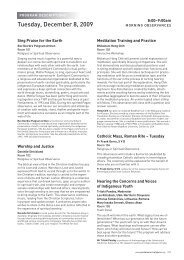Whispers and Vanities in Samoan Indigenous Religious Culture
Whispers and Vanities in Samoan Indigenous Religious Culture
Whispers and Vanities in Samoan Indigenous Religious Culture
Create successful ePaper yourself
Turn your PDF publications into a flip-book with our unique Google optimized e-Paper software.
eflected manhood or womanhood more than a desire to cover the sk<strong>in</strong>. In public it<br />
was only the genitals that were kept covered <strong>and</strong> this was <strong>in</strong> protection of their<br />
sacredness. The female breasts were not necessary for the conception of new life <strong>and</strong><br />
so not afforded the same tapu as the genitals.<br />
The public display <strong>and</strong> deliberate flaunt<strong>in</strong>g of the genitals only really occurred dur<strong>in</strong>g<br />
formal sacred events such as dur<strong>in</strong>g t<strong>in</strong>i or marriage rituals or auala or funeral rituals<br />
<strong>and</strong>/or at the p<strong>in</strong>nacle moment <strong>in</strong> poula 24 where the beauty <strong>and</strong> sexuality of the body<br />
was flaunted <strong>in</strong> dance, such as dur<strong>in</strong>g the sa’ē 25 (one of the prelim<strong>in</strong>aries before the<br />
taualuga 26 ). Sexuality <strong>in</strong> this context was always to be read as ultimately aimed<br />
towards procreation <strong>and</strong> as an endowment from God Tagaloa <strong>and</strong> a rem<strong>in</strong>der of the<br />
div<strong>in</strong>ity we shared with him.<br />
In th<strong>in</strong>k<strong>in</strong>g about the sa’ē dance the custodian smiles. The sa’ē <strong>in</strong>volved anyone,<br />
except children, who wanted to jo<strong>in</strong> <strong>in</strong>. In be<strong>in</strong>g the dance that needed to create the<br />
right ambiance for the taualuga <strong>in</strong> the faafeagaiga o aumaga ma aualuma 27 , where it<br />
was hoped that by the end of which sex would occur (except for those who had to<br />
preserve themselves for political reasons), the words <strong>and</strong> movements of the sa’ē were<br />
deliberately designed to provoke a sexual reaction. The sa’ē sent the message that <strong>in</strong><br />
the clearly def<strong>in</strong>ed <strong>and</strong> monitored space of the faafeagaiga o aumaga ma aualuma,<br />
sexuality can <strong>and</strong> should be celebrated publicly.<br />
The ritual dance of the sa’ē is an unsynchronised dance that would beg<strong>in</strong> with the<br />
young virg<strong>in</strong>s enter<strong>in</strong>g the dance house first, followed by more mature women <strong>and</strong><br />
then the more elderly women. 28 Dur<strong>in</strong>g the dance the women would tease <strong>and</strong><br />
tantalise the audience by expos<strong>in</strong>g themselves openly through generous <strong>and</strong><br />
gregarious dance movements <strong>and</strong> by chant<strong>in</strong>g or shout<strong>in</strong>g sexually-explicit phrases to<br />
provoke reaction from the men. The men would usually respond by approach<strong>in</strong>g the<br />
young virg<strong>in</strong>s <strong>in</strong> exaggerated bashfulness, play<strong>in</strong>g coy by attempt<strong>in</strong>g to hide their<br />
genitalia with a leaf or piece of cloth. The older women would mock them <strong>and</strong> the<br />
men would <strong>in</strong> turn respond. After this to <strong>and</strong> fro of words <strong>and</strong> gestures (all performed<br />
<strong>in</strong> dance <strong>and</strong> chant form), the men then do away with the leaf or cloth cover<strong>in</strong>g their<br />
genitalia, fully expos<strong>in</strong>g themselves to the women <strong>in</strong> great merriment while try<strong>in</strong>g to<br />
catch the attention of those female dancers they fancy.<br />
In this forum the male <strong>and</strong> female dancers have to be comfortable with their<br />
nakedness <strong>and</strong> <strong>in</strong> the public display of their sacred parts. This was achievable then<br />
because <strong>Samoan</strong> social <strong>and</strong> religious discourse perceived the sexual organs not as<br />
<strong>in</strong>struments of s<strong>in</strong>ful pleasure but as gifts from God Tagaloa.<br />
24<br />
Literally the term refers to the night of the shrimp. People tended to see the behaviour of the<br />
shrimp as hyperactive or very energetic. They were believed to be prolific breeders <strong>and</strong> assumed to be<br />
very sexual. Poula captures these metaphoric mean<strong>in</strong>gs.<br />
25<br />
Richard Moyle draws on the journals of the missionary John Williams to describe this dance.<br />
The quote cited by Richard (1975, p.240-241) is taken from John Williams journal 1832/1833.<br />
26<br />
Taualuga (taua mean<strong>in</strong>g com<strong>in</strong>g together; luga mean<strong>in</strong>g high) is a shortened version of the<br />
term taumaualuga, mean<strong>in</strong>g peak meet<strong>in</strong>g po<strong>in</strong>t <strong>in</strong> the roof of a house. The term taualuga thus refers<br />
to the high po<strong>in</strong>t or p<strong>in</strong>nacle of an event. In this case, it is the high po<strong>in</strong>t <strong>in</strong> the poula.<br />
27<br />
This is literally the meet<strong>in</strong>g (faafeagaiga) between the (o) untitled men’s guild (aumaga) <strong>and</strong><br />
ladies’ guild (aualuma).<br />
28<br />
The evidence for the retell<strong>in</strong>g of this dance form is taken from Richard Moyle’s article on<br />
<strong>Samoan</strong> sexuality. See Moyle (1975).<br />
13











